Devin Devine, contractor based out of Blakeslee Pennsylvania, projects competed across the USA
contact devin@devineescapes.com
1 on 1 phone consultations
DIY hardscape/masonry/flagstone help rates:
$123.00 for one hour
$80 for a half hour
Monies are payable via Venmo, paypal or zelle.
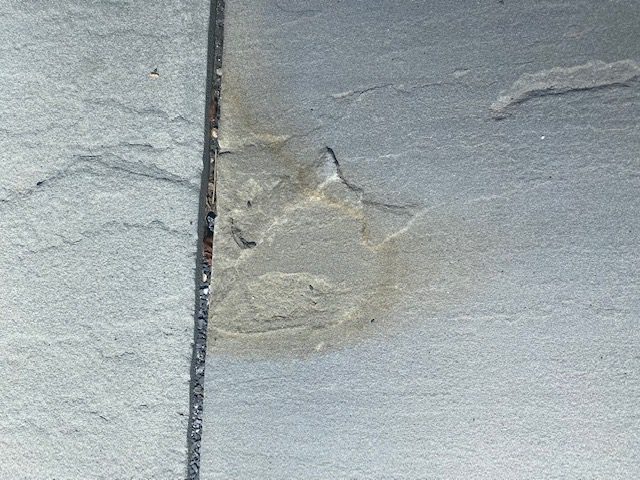 Rusty spots on bluestone
Rusty spots on bluestone
I received an email recently, from a customer of mine:
Hope you are well. We are enjoying the stone patio you laid earlier this year. Really a great job. However, I recently noted some rust-like spots developing on some of the stones (see images attached). Do you have any tips on what causes these and how to clean them off or prevent future ones?
–a valued customer of mine, in D.C
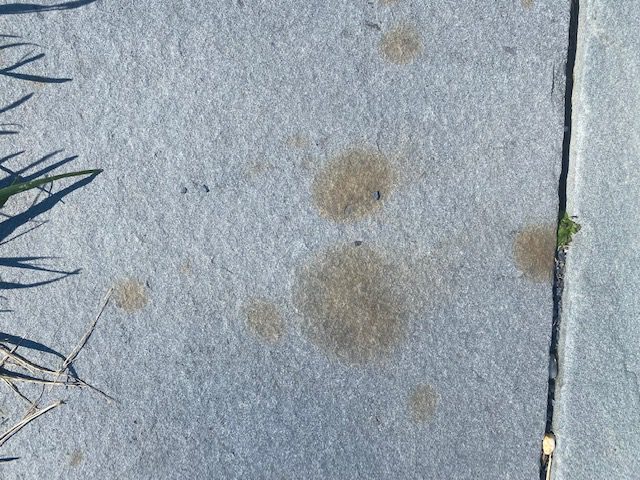
And I responded:
Bluestone contains many minerals, including iron. The rust-like spots
are probably iron oxides.Unfortunately, it’s tough for me to say just what the proper cleanup
method here is–sometimes acid works, sometimes it doesn’t. What I’ve
done in the past is used muriatic acid, well diluted, and a regular
scrub brush–not a wire brush, but a plastic brush, or something
similar.If the iron is mostly close to the surface, then gentle scrubbing + acid
should remove it. If it’s deeper into the stone, then it won’t help
much.I would try using just white vinegar for now, and a scrub brush. Let
me know how that goes–next step is to carefully try muriatic acid…The reason (as I understand it) that this works: acid causes iron to
rust. It speeds up the oxidation process. To date, I’ve successfully
used this to make bright orange deposits disappear. Dull looking spots
like this, I don’t know. These bright orange spots tend to be mostly a
surface phenomenon. These dull spots however…..I’ve seen bluestone
where the entire stone is this dull color–break the stone in half,
the color goes all the way through the stone, you can see it in the
middle. If this is the case, then there’s no cleaning it.
Buy this type of muriatic acid (it should be labeled as “for etching” or cleaning concrete, not the stuff that’s meant for swimming pools).
What causes rust on bluestone?
Iron. More specifically, iron pyrite. More on that, down below.
How to remove rust on bluestone–can you clean it off?
Sometimes you can–sometimes you can’t!
I’ve had luck removing bright orange rusty spots from the surface of bluestone, by using a scrub brush and diluted muriatic acid. This only works on surface rust–if the stone has a thin deposit of iron close to the surface. If the iron and rustiness go deeper, then I don’t see this working.
No, do not seal bluestone.
I’ve addressed this issue before.
And yes, you can clean up using acid
….but dilute it well and rinse off fast. Never, in 25 years have I seen a piece of bluestone ruined using acid.
I’ve seen inexperienced guys mess up limestone, as well as concrete and mortar using acid–but never have I ever seen bluestone damaged by acid. The same guys recommending you never use acid on bluestone…they also recommend you seal bluestone. With no science to back up either claim. Meanwhile acid is dangerous to lime stone and cement–for the same reason that your 8th grade science project volcano worked–because the limestone and cement are like baking soda, highly alkaline, and acid will react with that. (bluestone is not highly alkaline). Likewise, sealing a stone is unwise because water still gets in, but it can’t get out. Never seal, only use acid with caution.
But why bother removing? Why bother “cleaning” naturally occurring rust from a stone’s surface?
Some of us like the orange.
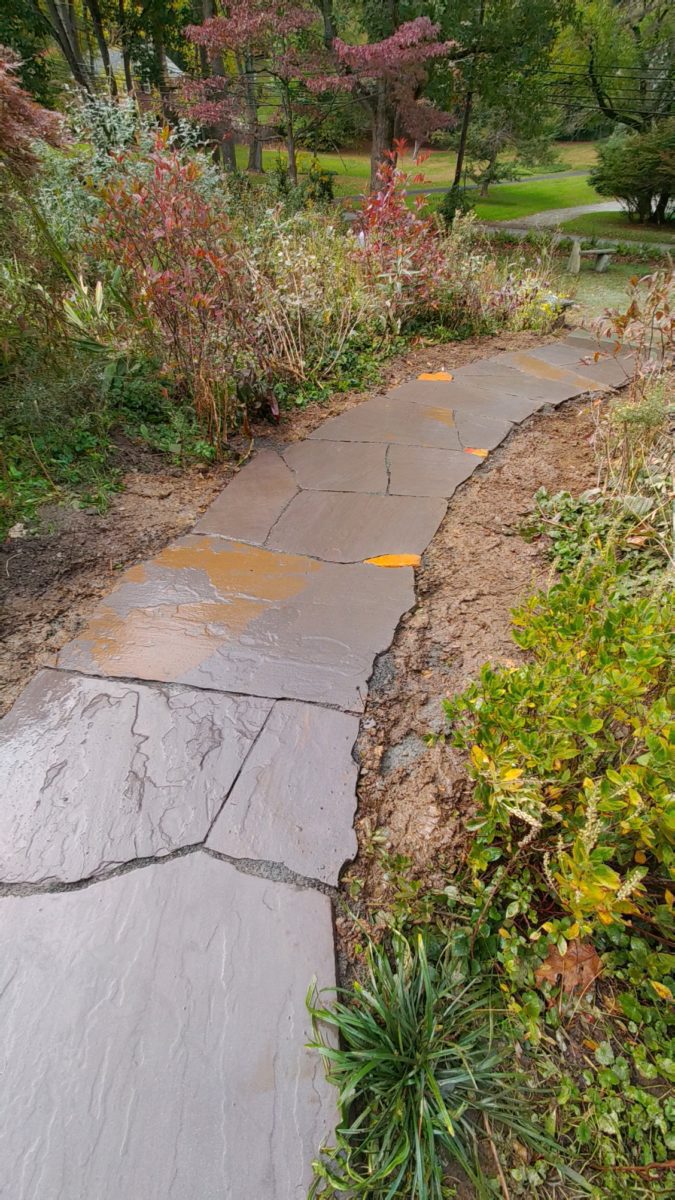
On this job I not only used all the orange rusty flagstones that came on the pallet, but I also used three bright orange pieces of quartz from the garden. A minor artistic embellishment, a bit of a pop of color. These three quartz pieces are smaller, but thicker than the rest of the patio stones, much thicker, for stability.
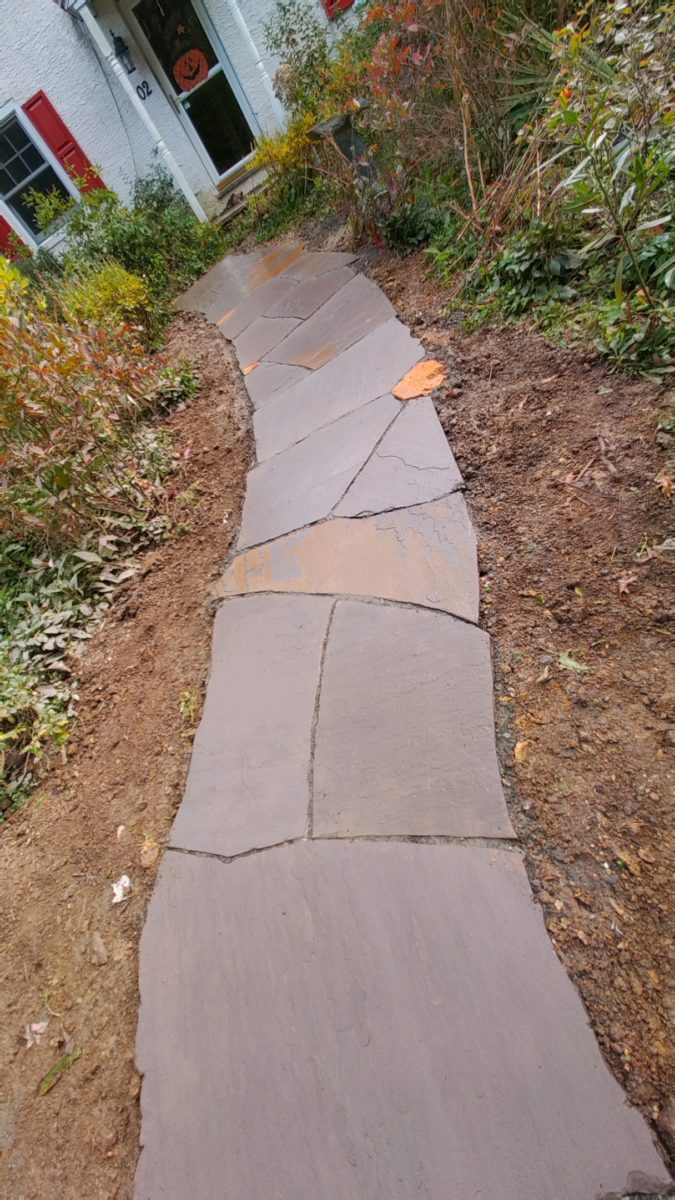
Now the flagstone slabs used here are probably cleanable. Both me and my customer like the orange so I didn’t try. But past experience tells me, just by the look of it–that this is the surface rust, it will not penetrate deep into the stone–and thus it would be cleanable. If we wanted too.
rusty rainbow beauty
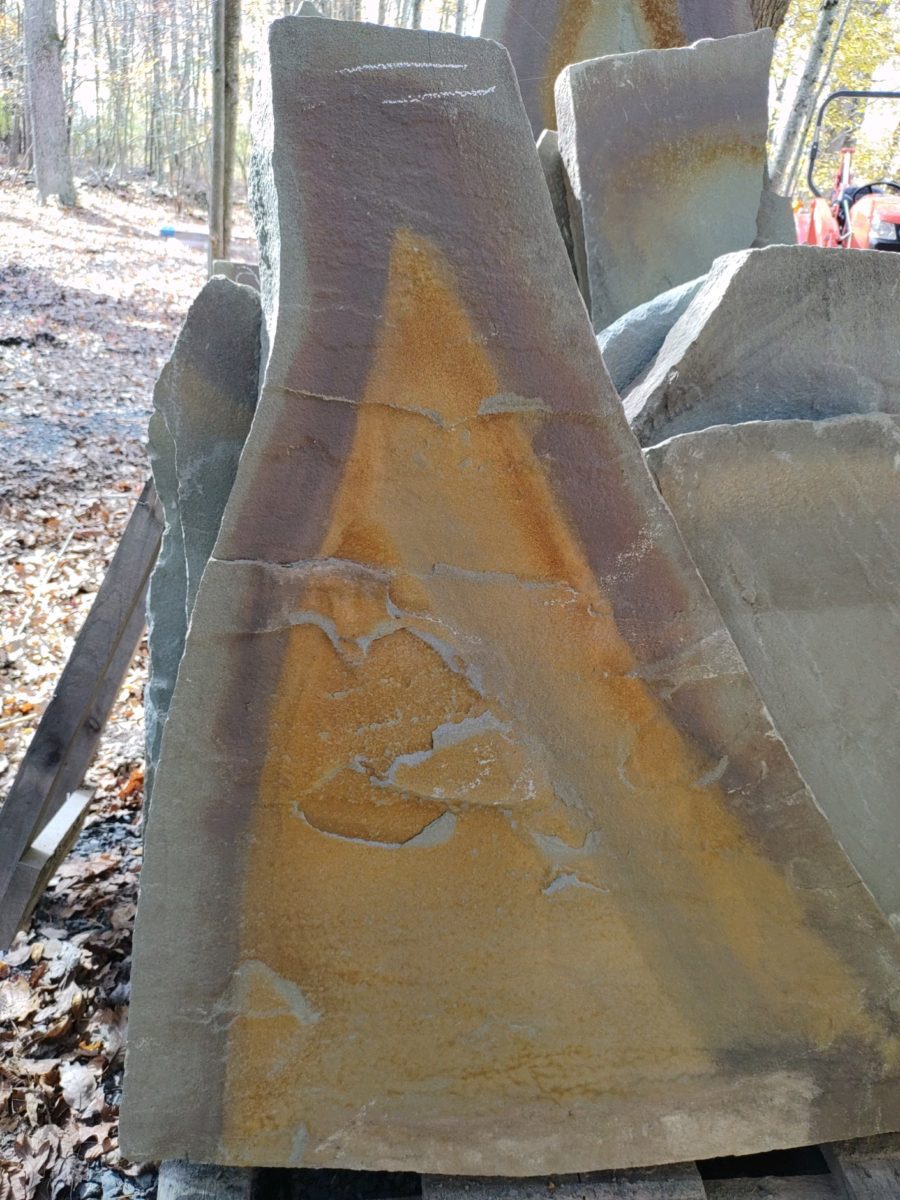
I think that the real problem of rust on bluestone is in the name; bluestone. People hear that name, and then they see expect to see “blue”. Then, they see an example of bluestone that happens to be actually blue, as in blue–not green, brown, or purple. Blue. So now they really want that blue. So anything non-blue is now a blemish? Most of the universe is a blemish then! Heck your favorite song is a blemish upon the perfect blue silence of nothingness. Life itself……a blemish upon the cool tranquility of a silent cosmos. Famous painters made entire careers out of ruining the perfect monotone white of all those canvasses. Am I still not getting through? (Help, I’m a sentence trapped in parenthesis!)
Then again…I’ve only heard such complaints from people who purchased either true blue bluestone, or lilac bluestone. Both of these products are selected for a particular color. I don’t believe I’ve ever known someone who purchased full-color bluestone aka variegated bluestone–and then complained of rust.
Related content:
- can you seal flagstone?
- how to cut flagstone using a hammer
- what type of flagstone to use?
- flagstone versus pavers, cost and value
Bluestone bench, all rusty with iron oxide purple, orange and olive-green:
Pyrite Spheres
So back in 2013 I built my second stone sphere–right after finishing, as I was loading up the leftover stone, I found that many of the stones had these sphere shaped inclusions. Wow. I’d never seen this before….I pried lose/chiseled them out and during the process, a few of them split in half–revealing that the insides of these balls looked like pyrite. But i wasn’t certain.
Years later, I find this piece of bluestone, at a stone supplier–and it is covered in these pyrite half spheres, each one of them leaking rust all over the place.
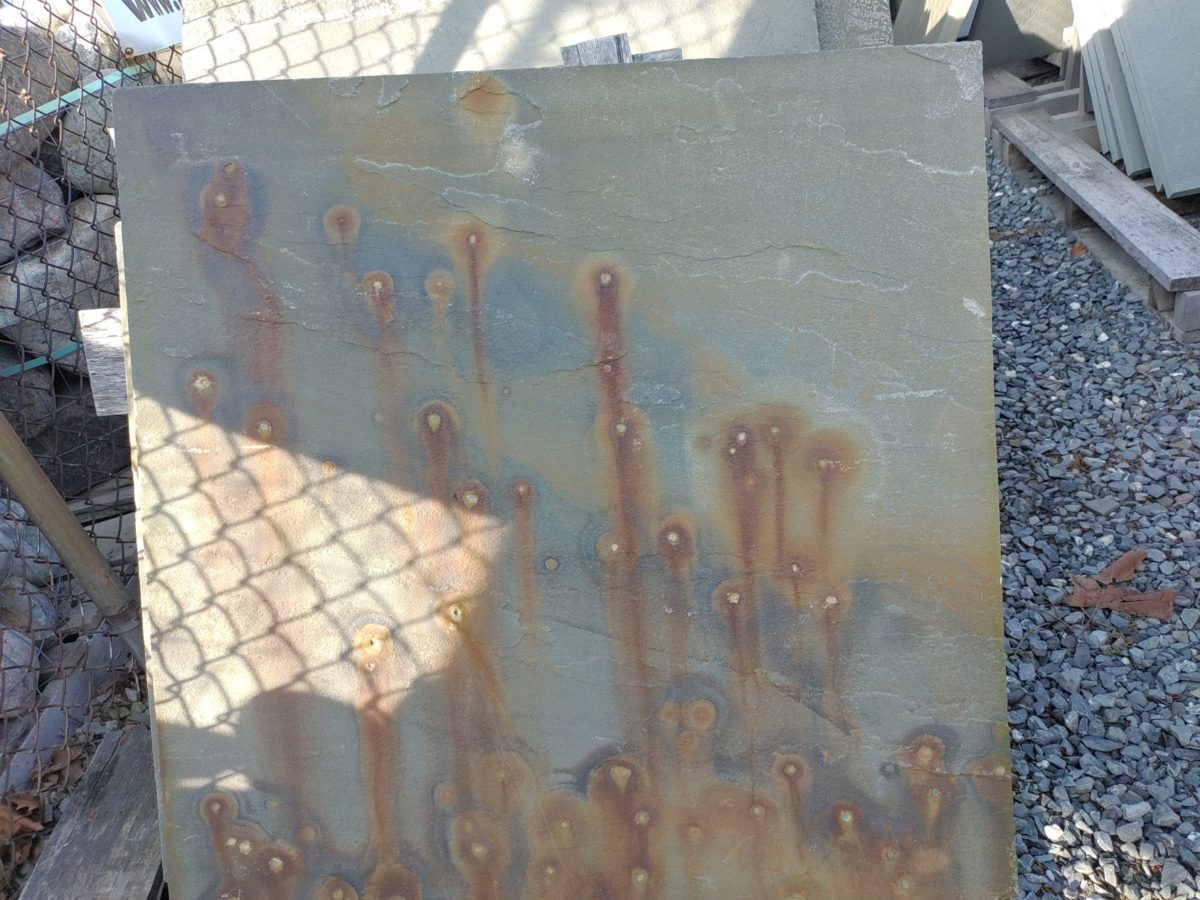
I’ve read somewhere that the rust that seeps out of bluestone comes from iron pyrite. So the pyrite phenomenon and the rust phenomenon are both part of the same aspect of bluestone. Pyrite is aka fools gold, a type of an iron sulfide with the chemical formula FeS2. Everyday you learn something! Sometimes mysteries answer themselves, years later, and that’s pretty cool.
But why is this pyrite sphere (ish) in shape, not cube, like pyrite usually is?
I don’t know yet–the mystery continues! Don’t forget to subscribe to this blog and leave a comment below. Thanks!
DIY Hardscape Help
Phone Call Rates:
$119.00 for an hour long consultation.
$80.00 for a half-hour consultation.
These consultations can also be conducted via email.
Monies are payable via Zelle, PayPal, Venmo or check. Add $3 for paypal payments.
Just email me to let me know you have a question, tell me your phone number, and we can then arrange a time for me to call you. Usually, I can fit you in within a couple days. Then, you go to paypal or zelle and pay me, using my email which is:
devin@devineescapes.com